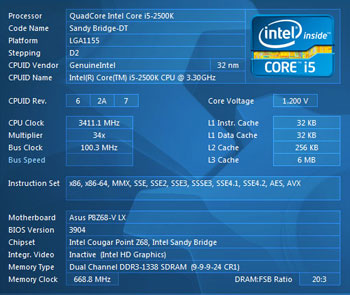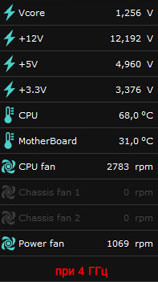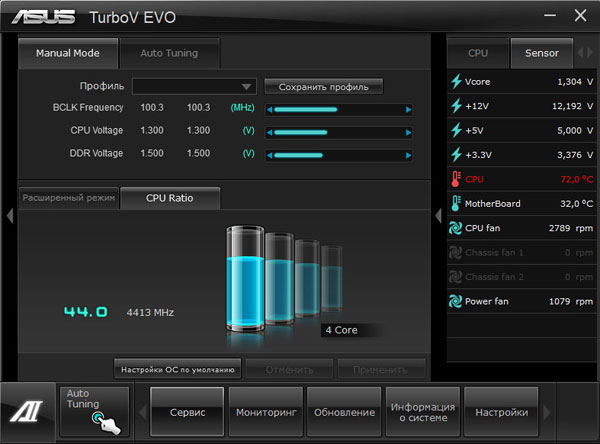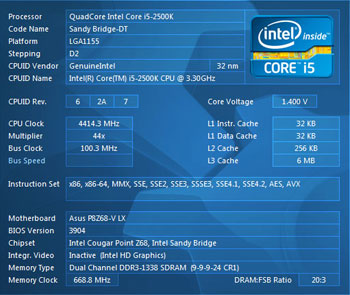Overclocking for everyone. "Home" overclocking processor with an open multiplier

It so happened that for nearly twenty years of IT practice I never had to deal with overclocking - others somehow all had interests. Nevertheless, selecting the configuration for the next new (although now far from new) computer, for some reason I stopped on an Intel processor with an open multiplier - i5-2500K. Why did I do this, now I don’t remember, perhaps I was supposed to sort it out in my old age, what is this overclocking. And then one evening, when there was nothing to do, I realized that the moment had come, and went deep into studying the question, and the next evening I applied what I had learned in practice. About what I am going to report.
Overclocking theory
Questions of overclocking interested mankind all the time from the moment the computer technology came to the masses. The main mover of overclocking is the spirit of competition, excitement, the desire to achieve better results than others. But its main object is innocent processors, which subject inhuman loads to obtain these very results. There are two main ways to overclock the processor. The first is an increase in the frequency of the BCLK clock generator, which, through multipliers, determines the frequency of the processor, memory, buses and bridges. This option is in principle universal, but it has many nuances and limitations associated with a specific processor and motherboard, so that your experiments do not lead to the death of the computer, you need to thoroughly understand everything. The second way is to change the multiplier of the processor, the one by which the BCLK is multiplied, so that the operating frequency is obtained. This path is much safer (only the mode of the processor, not the entire system, is changed) and simpler (essentially one parameter is responsible for overclocking), but there is one thing: the multiplier must be unlocked (allowed for change) by the processor manufacturer.
There are two main ways to overclock the processor. The first is an increase in the frequency of the BCLK clock generator, which, through multipliers, determines the frequency of the processor, memory, buses and bridges. This option is in principle universal, but it has many nuances and limitations associated with a specific processor and motherboard, so that your experiments do not lead to the death of the computer, you need to thoroughly understand everything. The second way is to change the multiplier of the processor, the one by which the BCLK is multiplied, so that the operating frequency is obtained. This path is much safer (only the mode of the processor, not the entire system, is changed) and simpler (essentially one parameter is responsible for overclocking), but there is one thing: the multiplier must be unlocked (allowed for change) by the processor manufacturer. Initially, Intel processors had an open multiplier, but in the 90s of the last century, after a series of scandals involving the remarking of processors by unscrupulous vendors, when the slow processors were accelerated and sold at the price of faster ones, the company blocked the multiplier. Since then, the unlocked multiplier has been found only in the top models for “enthusiasts”, which, of course, were expensive. The situation has fundamentally changed with the advent of second-generation Intel Core processors (Sandy Bridge) - models with an unlocked multiplier for the mass market were present in their lineup. They received an K index. Initially, the K value and the non-K version of a single processor differed quite significantly, but now it has almost disappeared no (for example, the difference between the Core i5 3570 and Core i5 3570K today is 150 rubles).
Initially, Intel processors had an open multiplier, but in the 90s of the last century, after a series of scandals involving the remarking of processors by unscrupulous vendors, when the slow processors were accelerated and sold at the price of faster ones, the company blocked the multiplier. Since then, the unlocked multiplier has been found only in the top models for “enthusiasts”, which, of course, were expensive. The situation has fundamentally changed with the advent of second-generation Intel Core processors (Sandy Bridge) - models with an unlocked multiplier for the mass market were present in their lineup. They received an K index. Initially, the K value and the non-K version of a single processor differed quite significantly, but now it has almost disappeared no (for example, the difference between the Core i5 3570 and Core i5 3570K today is 150 rubles).
So, Intel itself opened the way for "home", fast and requiring high qualification, overclocking. Sin did not take advantage of this opportunity, and I began my experiments. As I already said, my long-suffering home computer, by the way, was not prepared for overclocking, rather the opposite, chosen for reasons of economy and noiselessness, as a test bench.
')
Experiment
According to the specification, the i5-2500K works on multipliers from 16 to 56. With standard parameters and using SpeedStep, we have 16x in idle and 34x under load. Now run the process. "Home" overclocking has become so domestic that it can now be performed directly from Windows, without entering the BIOS. But we will still be oldfags for starters - only BIOS, only hardcore! However, special hardcore will not work - there we will need only one parameter; In the BIOS of my ASUS P8Z68-V LX motherboard, it is called CPU Ratio and is located in the CPU Power Management menu. To overclock the processor above standard values, you will also need to enable the Turbo Mode option (it does not apply to Intel Turbo Boost, which, on the contrary, is recommended to be turned off).
"Home" overclocking has become so domestic that it can now be performed directly from Windows, without entering the BIOS. But we will still be oldfags for starters - only BIOS, only hardcore! However, special hardcore will not work - there we will need only one parameter; In the BIOS of my ASUS P8Z68-V LX motherboard, it is called CPU Ratio and is located in the CPU Power Management menu. To overclock the processor above standard values, you will also need to enable the Turbo Mode option (it does not apply to Intel Turbo Boost, which, on the contrary, is recommended to be turned off).The first overclocking was tiny, up to 36x, in order to commemorate my entry into the ranks of overclockers. However, fanfare did not follow, and nothing happened at all, except for the frequency in the CPU monitor. The temperature also remained unchanged. The next level is 40x, a significant figure, more recently such a result (during overclocking “through the bus”) was considered a grandmaster. The height was taken without the slightest effort and without changing the voltage on the processor. But the temperature, unfortunately, crept upwards and at 100% load reached 68 degrees. Nothing can be done, the cooling system installed on the computer, proved to be completely unsuitable for overclocking.

Step three. 44x, i.e. 1 GHz increment. Having made a face a brick, I started the computer. "Well, no, enough," he replied and flew into the blue screen. It is necessary to increase the voltage of the processor. I immediately raised to 1.4 V, so that was enough. Now I decided to act through the GUI in Windows. In the AI Suite software that comes with the ASUS motherboard, Turbo V EVO component is responsible for overclocking. For its work, this program uses the TPU (TurboV Processing Unit) controller on the motherboard. The TPU module is so intelligent that it can itself, without human intervention, disperse the system to the maximum possible parameters. Thus, the overclocking technology, from the point of view of the “teapot”, has reached its highest point, when in order to get the result, it’s enough to press one button “to make it all zashib”.
 I really didn’t succeed in testing the 4.4 GHz mode, because a few seconds after launching the full load, the temperature rose to the maximum allowable, and I was forced to interrupt the experiment. However, I have no doubt that with normal cooling, the operation of the processor would be stable - I am convinced of this by numerous experiments of other users. If we talk specifically about the i5-2500K, then up to 4.5 GHz processors work absolutely for everyone, the result of 5 GHz is quite common, and the most hard-nosed ones have reached 5.2 GHz. I emphasize that we are talking about stable work with a large (test or real) load. Thus, we are dealing with more than 50% increase in frequency with minimal material and mental costs.
I really didn’t succeed in testing the 4.4 GHz mode, because a few seconds after launching the full load, the temperature rose to the maximum allowable, and I was forced to interrupt the experiment. However, I have no doubt that with normal cooling, the operation of the processor would be stable - I am convinced of this by numerous experiments of other users. If we talk specifically about the i5-2500K, then up to 4.5 GHz processors work absolutely for everyone, the result of 5 GHz is quite common, and the most hard-nosed ones have reached 5.2 GHz. I emphasize that we are talking about stable work with a large (test or real) load. Thus, we are dealing with more than 50% increase in frequency with minimal material and mental costs.Results and conclusions
As expected, the results of computational tests crawled linearly up with increasing frequency. For example, I chose the CPU Queen integer "chess" test. As you can see, at maximum overclocking, our processor “pushed” not only the extreme i7 of the first generation, but also the server Xeon (although initially inferior to both).
Someone is probably wondering what happened to the Windows performance index? Practically nothing, it increased by only one tenth, from 7.5 to 7.6. However, one should not forget that for Windows 7 the maximum value of the index is 7.9, therefore a big jump could not happen.

Now let's try to answer the question, who needs this overclocking - except, directly, overclockers? To him, however, answered to us: first of all - lovers of computer games. Experiments have shown that the processor power at standard frequencies is not enough to power top-end video cards, especially if there are several of them, and as the frequency rises to a certain limit, the performance in games also grows. Saturation comes, by the way, on our “home” 4-4.5 GHz, it is at this frequency that the processor ceases to be the “bottleneck” of the entire system. In addition, the extra gigahertz will definitely welcome people dealing with heavy media content, and, of course, dear fans of distributed computing. I note that all categories of citizens will have to keep a close eye on the temperature of the processors and their cooling system - otherwise, a light "puff" and smoke will be provided.
Source: https://habr.com/ru/post/176331/
All Articles